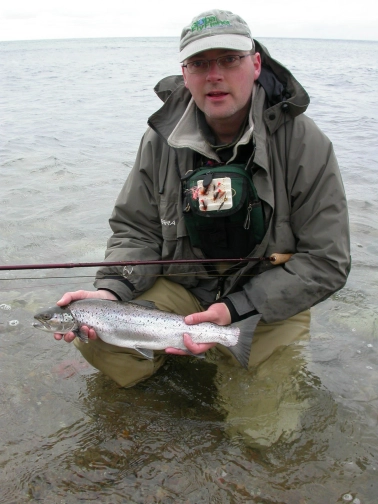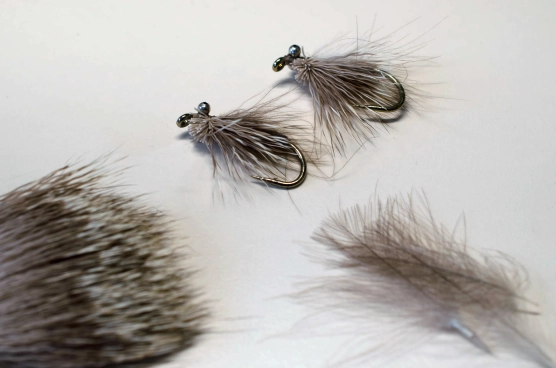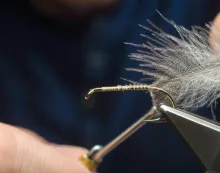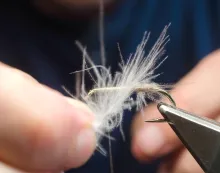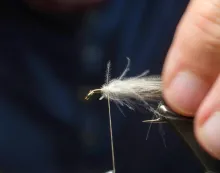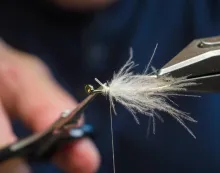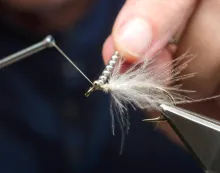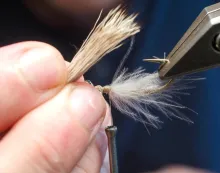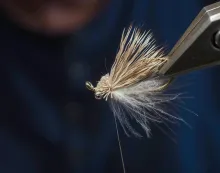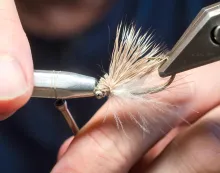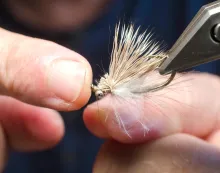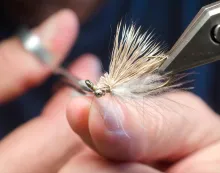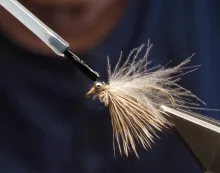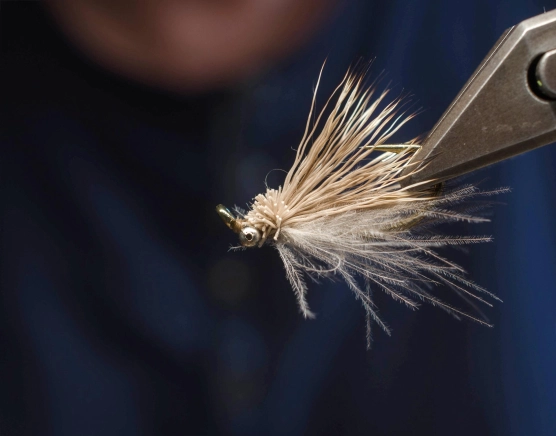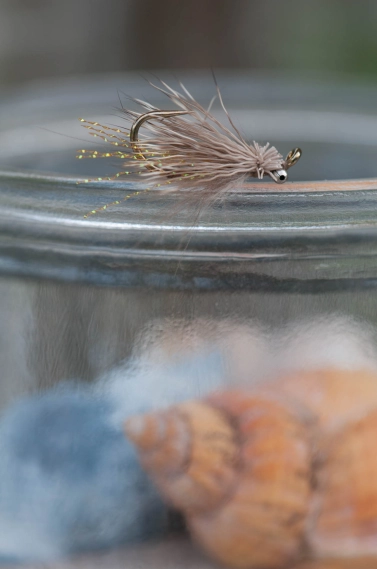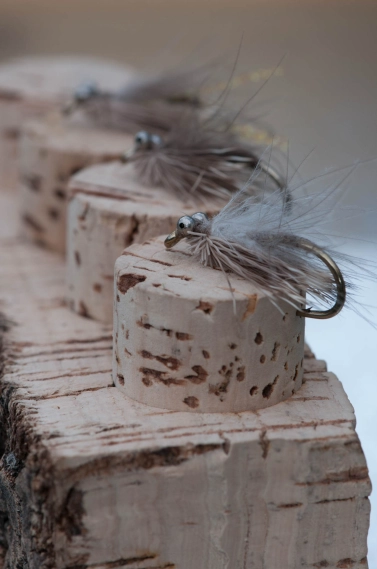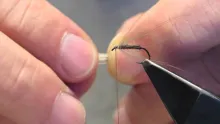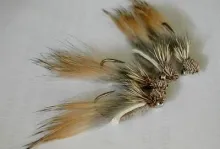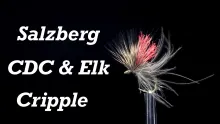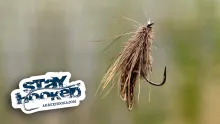The CDC&Elk is a famous and efficient Caddis dry fly. This variation works for Baltic sea trout... and was actually inspired by the bonefish version of the fly
CDC is almost a magic feather, and the CDC&Elk is almost a magic fly. In this version it has inspired a sea trout fly.
I was introduced to the CDC&Elk by Hans Weilenmann, the originator himself. I have loved the fly ever since and always keep it in my stream fly box. it's worked for me basically all over the world wherever I have fished for trout in still or moving water.
The fly is simple, yet a brilliant little impression of an insect, CDC acting as legs, body, antennae and even a tail if the fish want to see it that way. The elk hair is the head, the thorax – and the wing, of course.
Welsh Paul Slaney converted this caddis fly to a bonefish fly. Tying it on a larger hook, adding eyes, flash and some weight, but keeping the same basic scheme, he transformed it into a fly with the traits liked by bonefishermen: shrimp-like, stealth, fishing upside-down.
Many years ago
Back in the spring of 2004 I was fishing on the Danish island Bornholm with a bunch of friends. People who have fished there know that the water can be quite clear in the ocean around this rocky island. Thanks to the rocks and the exposure to the Baltic waves and currents, very little silt finds rest on the bottom, and when the water moves, it rarely becomes cloudy as is the case in many other Baltic waters. On calm and sunny days, this means that the water is as an aquarium. Quite beautiful and fascinating, but also a curse when it comes to catching sea trout. The fish simply see everything, and suddenly stealth becomes an issue.
In such a case a nice, soft, subdued fly is a good choice. Small flies fished on long thin leaders can also do it, but a fly that lands softly and seeks to the bottom without making too much visual noise can be a key. Such a fly is Paul Slaney's Bonefish CDC&Elk, and I thought I'd tie some of those. Bonefish are notoriously spooky, and if it could catch spooky bonefish, it ought to be able to fool a spooky sea trout.
In the eyes...
I hadn't seen the fly, but just heard it mentioned, and could conclude from the hearsay that it was essentially tied as the original, but on a larger hook and with eyes.
Back then – as to a large extent also now – eyes on my flies meant bead chain eyes. My guess was that Paul had used dumbbell eyes, which are the type most commonly used on bonefish flies, and I'd simply exchange them for my beloved bead chains. Later I discovered that Paul had actually used bead chain for weight, and mono eyes for "real" eyes, lending his fly a very shrimpy look.
My fly just had bead chain.
Kluting-style
Back in the late 90's I had tied a fly, which I called the Kluting, also an upside down fly with eyes, but using a zonker strip for the wing and deer hair for the head, tied to imitate a small fish more than a shrimp. With an outset in that style, I picked a fairly heavy down eye wet fly hook, my favorite Kamasan B175, and used that for my sea trout version of the CDC&Elk.
This CDC&Elk pattern actually turned out more like the Blackout Kluting, a later, smaller and duller incarnation of the Kluting. So it goes when flies are tied on the base of just a name.
Tying sequence
|
|
|
|
|
|
|
|
|
|
|
|
|
|
|
|
|
|
|
|
|
|
|
|
|
|
|
|
|
|
|
|
|
|
|
|
CDC in the ocean
You might argue that the delicate nature and physiology of the CDC feather doesn't really play a role in saltwater flies. That's reserved for dry flies where the small bubbles and the hydrophobic nature of the feather comes to its right.
I beg to differ.
The delicacy is indeed useful in the salt too, and the fact that the body on this fly catches small air bubbles both helps the fly sink slowly and makes it look more natural. Combined with the deer hair wing, it allows this fly to make a very gentle touchdown on the surface, and descent very slowly – sometimes almost too slow for the impatient angler.
The proper CDC-feathers
You will need some fairly large CDC-feathers of type 4 (see Hans Weilenmann's article on CDC). The feathers I have used here are in the 4-4.5 centimeter length and more than long enough for the size 4 hook I used. But it's not easy to fine these feathers unless you buy them purposely large. Most sorted CDC-feathers are of the types 1, 2 and 3, which are popular for dry flies and emergers. I have once aquired bulk bags of CDC-feathers and sorted them, and a number of these feathers are large type 4 feathers. These are often considered useless for smaller flies unless they are cut up for dubbing or used as loose fibers in other ways.
If you don't want to buy bul, you can contact Czech David Jedlicka on Facebook. He sells sorted feathers in all sizes.
Kasper Mühlbach
Upside-down
The way the fly is constructed makes it swim upside-down. The heavy hook and the eyes will pull the fly under, but the light wing, tied on the underside of the hook will basically act as an "inverse keel" or a "rudder" and turn the fly over, orienting it point up. That's perfect, because the fly is supposed to be fished on the bottom or right over the bottom, and the upwards pointing hook point will help avoid snags.
Bonefish will like it
From my experience with bonefish, I don't doubt that they would love this fly. Tie it in a size 2 or 1/0 on a saltwater hook, and you have a fly suited for the stealthy fishing for the ghost of the flats. Tied for bonefish or sea trout, you can add a little weight to the fly to get it to sink more quickly, and if you feel like it, a few straws of flash in clear, tab or pink can make the very dull fly a little more visible.
Go low, go slow
When fishing for sea trout, the Sea Trout CDC&Elk is useful on bright days with clear and calm water, and – unless you have added some weight – also shallow water, like 2-3' or about a meter deep. In this water the fly will reach the bottom within some seconds, and thanks to the soft materials, it won't disturb the surface much. Make sure you fish with a sufficiently long leader – 1-1½ rod lengths – and don't go too thick. A loop knot will allow the fly to work and orient itself in the water. And my usual gospel: make sure you stretch your leader in the cast, so that the fly lands correctly and ready to fish. I'm convinced that a lot of sea trout are deterred from going after the fly because it lands in a pile of curled up leader and tippet.
Hand picked for this article
- Log in to post comments


